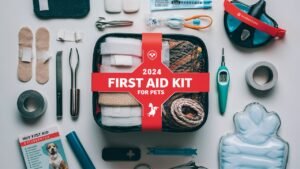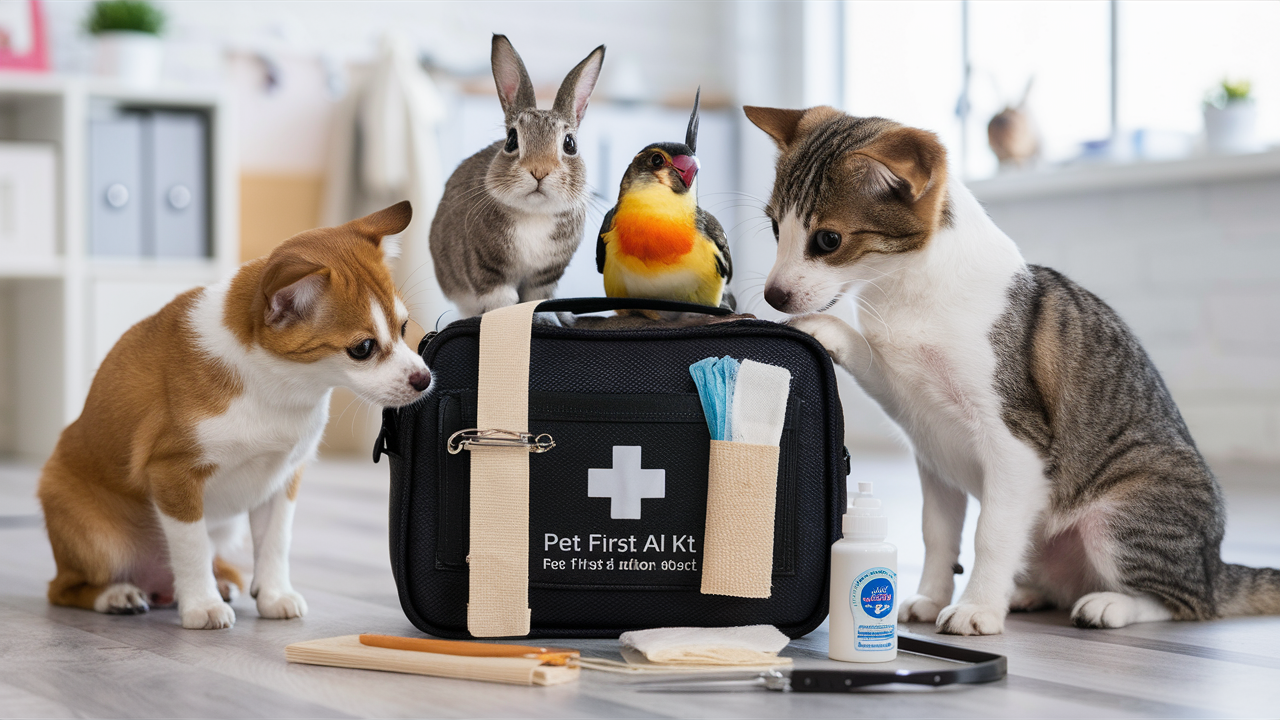Discover the essential items for a Pet First Aid Kit and learn how to prepare for emergencies with your furry friend. Our comprehensive guide covers must-have supplies, practical tips, and expert advice to ensure you’re ready to handle any situation with confidence.
Introduction

When it comes to our beloved pets, their safety and well-being are top priorities. Just like with human first aid kits, having a well-stocked pet first aid kit is crucial for handling emergencies. Whether it’s a minor injury or a more serious health issue, being prepared can make all the difference. In this article, we’ll dive into the essentials of a pet first aid kit, ensuring you’re equipped to handle various situations that might arise.
Basic Components of a Pet First Aid Kit
1. Gauze Pads and Rolls
Gauze pads and rolls are foundational items in any first aid kit. They’re used to control bleeding, cover wounds, and protect injuries from further contamination. Ensure you have a variety of sizes to handle different types of wounds.
2. Adhesive Tape
Adhesive tape is vital for securing gauze and bandages in place. Opt for a tape that is gentle on your pet’s skin but strong enough to hold the dressings securely.
3. Antiseptic Wipes and Ointments
Antiseptic wipes and ointments help clean wounds and prevent infection. Always choose products that are safe for pets, as some human antiseptics can be harmful to animals.
4. Tweezers
Tweezers are essential for removing splinters, ticks, and other foreign objects from your pet’s skin. Ensure they are clean and have a fine tip for precision.
5. Scissors
Scissors with rounded tips are perfect for cutting gauze, tape, and even trimming fur around wounds. Avoid using regular household scissors, as they might cause accidental injuries.
6. Thermometer
A pet thermometer is crucial for monitoring your pet’s body temperature, which can help in identifying fever or hypothermia. Make sure to get a thermometer designed specifically for pets.
7. Emergency Contact Information

Include contact information for your veterinarian, local animal hospital, and an emergency pet poison control hotline. Having these numbers on hand can expedite care during a crisis.
8. First Aid Manual for Pets
A first aid manual specific to pets provides guidance on how to use the items in your kit effectively. It’s a handy reference in case you’re unsure how to treat a particular injury or condition.
Medications and Salves
1. Pain Relief Medication
Having pet-safe pain relief medication is important for managing discomfort. Always consult your vet before administering any medication to ensure it’s appropriate for your pet’s condition.
2. Anti-Diarrheal Medication
Diarrhea in pets can be caused by various issues, from dietary changes to infections. Anti-diarrheal medication specifically formulated for pets can provide relief while you determine the underlying cause.
3. Antihistamines
Antihistamines can help with allergic reactions. Again, it’s crucial to get advice from your vet on the correct type and dosage for your pet.
Wound Care Supplies
1. Sterile Saline Solution
Sterile saline solution is used to flush out wounds and clean them thoroughly before applying dressings. It’s gentle and safe for pets.
2. Hydrogel
Hydrogel can be used to keep wounds moist, which helps in faster healing and reduces pain. It’s especially useful for burns or dry, irritated skin.
3. Bandages
Different types of bandages, including self-adhesive and non-stick, are essential for dressing wounds. Ensure they are appropriately sized for your pet’s injuries.
Special Considerations

1. Items for Specific Breeds or Sizes
Tailor your kit to your pet’s breed or size. For instance, a small dog may need smaller bandages compared to a large breed.
2. Handling Pet Emergencies in Different Environments
Consider items that may be specific to your pet’s environment. For example, if you live in an area with ticks, ensure your kit includes tick removal tools.
How to Use Each Item Effectively
1. Administering Medication
When administering medication, follow your vet’s instructions carefully. Proper dosing is critical to avoid potential side effects.
2. Treating Cuts and Scrapes
Clean the wound with sterile saline, apply an antiseptic, and cover it with gauze. Secure the gauze with adhesive tape to prevent further injury or infection.
3. Handling Allergic Reactions
For allergic reactions, antihistamines can help, but always consult your vet first. Observing your pet’s symptoms will help determine if further medical intervention is needed.
Maintaining and Updating Your Pet First Aid Kit
1. Regular Checks and Replacements

Regularly check the contents of your first aid kit to ensure everything is up-to-date and in working condition. Replace any expired or used items promptly.
2. Expiry Dates and Storage Tips
Keep an eye on expiry dates for medications and ointments. Store your kit in a cool, dry place to maintain the integrity of the items.
Additional Tips for Pet First Aid
1. Basic CPR Techniques
Learning basic CPR for pets can be invaluable. It’s a good idea to take a pet first aid class to be prepared for situations where CPR might be necessary.
2. Recognizing Common Pet Emergencies
Understanding common emergencies, like choking or poisoning, and knowing how to respond can significantly impact your pet’s recovery chances.
Conclusion
As a pet owner, having a well-prepared first aid kit is not just a precaution but a vital tool for ensuring the health and safety of your furry friend. By stocking essential items and knowing how to use them, you’re better equipped to handle emergencies and provide immediate care. Take the time to assemble your pet’s first aid kit today and make sure to keep it up-to-date. Your proactive approach can make all the difference in a crisis.
FAQs
What should I include in a pet first aid kit for a cat vs. a dog?
Cats and dogs have different needs. While many items are the same, consider specific items for cats like flea combs or cat-safe medications. Dogs might need larger bandages or additional tick removal tools.
How often should I check and update my pet first aid kit?
Regularly check your kit at least every six months to replace expired items and ensure everything is in working order.
Can I use human medications on pets?
No, not without veterinary guidance. Many human medications are unsafe for pets, so always consult your vet before using any medication.
What are some signs that my pet might need emergency care?
Signs include severe bleeding, difficulty breathing, loss of consciousness, or poisoning. If in doubt, consult your vet immediately.
Where should I store my pet first aid kit?
Store it in a cool, dry place where it’s easily accessible but out of your pet’s reach. This ensures the kit remains effective and prevents accidental tampering.



